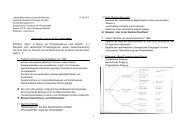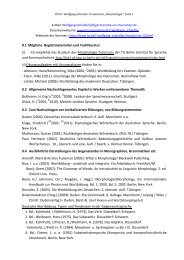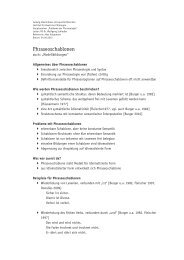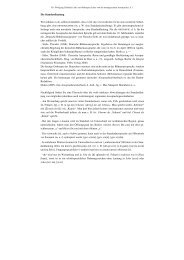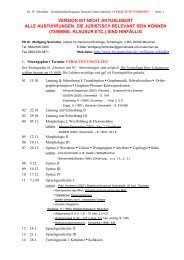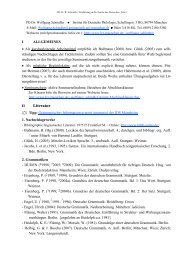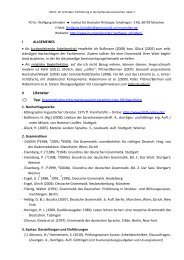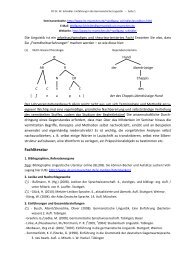Chapter 18 Lexical Functions: Description of Lexical Relations in a ...
Chapter 18 Lexical Functions: Description of Lexical Relations in a ...
Chapter 18 Lexical Functions: Description of Lexical Relations in a ...
You also want an ePaper? Increase the reach of your titles
YUMPU automatically turns print PDFs into web optimized ePapers that Google loves.
6.1.3 Different Semantic ‘Facets’ <strong>of</strong> a Keyword<br />
—<strong>Chapter</strong> <strong>18</strong>. <strong>Lexical</strong> <strong>Functions</strong>— 82<br />
The elements <strong>of</strong> the value f(L) can further be non-synonymous because the keyword L can<br />
be considered <strong>in</strong> different situations or, better, under different facets—and <strong>in</strong> these different<br />
facets it has different values with a given LF f. Two major classes <strong>of</strong> cases must be dist<strong>in</strong>guished:<br />
a facet is specified a) by the <strong>in</strong>stantiation <strong>of</strong> a SemA <strong>of</strong> L or b) by a particular angle from which<br />
the referent <strong>of</strong> L is considered.<br />
Facets def<strong>in</strong>ed by the value <strong>of</strong> a SemA<br />
Consider, for example, HEART2 (X’s imag<strong>in</strong>ary organ <strong>of</strong> emotion Y toward Z ...).<br />
• If the emotion is love, i.e., Y = LOVE, then Fact 3(heart2) = belongs [to NZ].<br />
• If the emotion is joy, then Fact 0(heart2) = s<strong>in</strong>gs.<br />
• If the emotion is sorrow, then Fact 3(heart2) = s<strong>in</strong>ks [at NZ] | NZ = idea,thought, ...<br />
• If the emotion is grief, then Fact 0(heart2) = bleeds.<br />
For Y = SORROW, Caus 3Fact 1(heart2) = break [NX’s ~];<br />
for Y = PLEASURE, Caus 3Fact 1(heart2) = warm [(the cockles <strong>of</strong>) NX’s ~];<br />
and for Y = PAINFUL FEELING, Caus 3Fact 1(heart2) = gnaw [at NX’s ~], pierce [NX’s ~].<br />
As can be easily seen, the elements <strong>of</strong> the values <strong>of</strong> different LFs differ, <strong>in</strong> their turn,<br />
accord<strong>in</strong>g to the SemA Y <strong>of</strong> HEART2.<br />
Facets def<strong>in</strong>ed by the perspective on L<br />
The referent <strong>of</strong> L may be used <strong>in</strong> different situations <strong>in</strong> various ways. Because <strong>of</strong> that, L<br />
may have different clusters <strong>of</strong> semantic derivations and collocates, each cluster correspond<strong>in</strong>g to<br />
a particular situation. To put it differently, L has different restricted cooccurrence as a function <strong>of</strong><br />
different situations <strong>of</strong> its use—<strong>of</strong> its different facets. To account for this, the lexical entry <strong>of</strong> L<br />
has to be divided accord<strong>in</strong>g to these facets. Let us illustrate this phenomenon with two examples:<br />
nouns BLOOD and NOSE.<br />
In English, the noun BLOOD is used under six different facets: as a ‘carrier’ <strong>of</strong> life (= blood<br />
circulation), as a signal <strong>of</strong> <strong>in</strong>jury or disease (bleed<strong>in</strong>g), as the target <strong>of</strong> medical treatment, as a<br />
symbol <strong>of</strong> temperament and feel<strong>in</strong>gs, as a symbol <strong>of</strong> life, and as a ‘carrier’ <strong>of</strong> biological orig<strong>in</strong>.<br />
Its lexical entry will show the divisions along these l<strong>in</strong>es.<br />
BLOOD (fluid circulat<strong>in</strong>g <strong>in</strong> the body...)<br />
1) Circulation<br />
blood vessels, arteries; B. flows/runs <strong>in</strong> X’s ve<strong>in</strong>s, rushes to X’s cheeks, ...


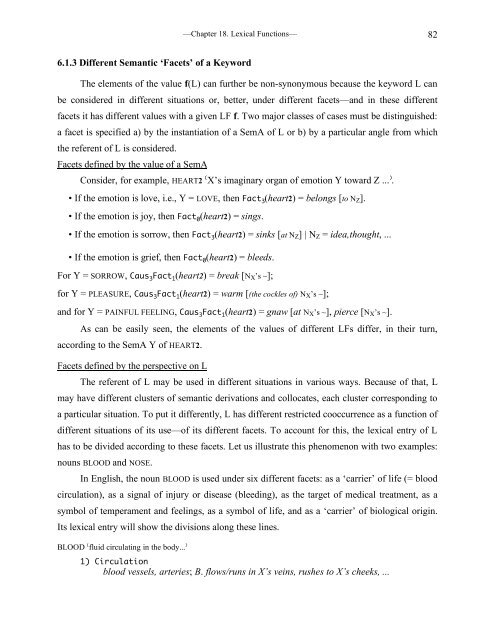
![E-Mail: Wolfgang.Schindler[ätt]germanistik.uni-muenchen.de Web ...](https://img.yumpu.com/51590147/1/184x260/e-mail-wolfgangschindlerattgermanistikuni-muenchende-web-.jpg?quality=85)
